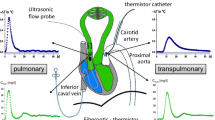Abstract
To differentiate between the effects of respiratory and metabolic alkalosis on respiratory mechanics, respiratory system resistance (Rrs) and reactance (Xrs) were examined in anesthetized, paralyzed, and mechanically hyperventilated dogs. Rrs and Xrs were measured by the forced oscillation method with a random noise input of 0–25 Hz. Restoration to normocapnia by CO2 inhalation significantly increased Rrs (+23.4±4.0%), particularly at high-frequency ranges without alterations in Xrs or resonant frequencies, whereas an increase in pH without changes in partial pressure of arterial carbon dioxide (Paco 2) by an administration of bicarbonate-carbonate mixture resulted in no significant alteration in Rrs or Xrs. A significant decrease in Rrs (−16.3±2.5%) following vagotomy or atropine administration was no longer affected by CO2 inhalation. These results suggest that (1) the vagus nerve appears to play a role in maintaining the resting tension of airway smooth muscle, (2) systemic hypocapnia decreases Rrs presumably due to the central airway dilation, and (3) this response is associated with a change in systemic partial pressure of carbon dioxide (Pco 2) rather than that in pH.
Similar content being viewed by others
References
Nadel JA, Widdicombe JG (1962) Effect of changes in blood gas tensions and carotid sinus pressure on tracheal volume and total lung resistance to airflow. J Physiol (Lond) 163:13–33
Green M, Widdicombe JG (1966) The effects of ventilation of dogs with different gas mixtures on airway calibre and lung mechanics. J Physiol (Lond) 186:363–381
Newhouse MT, Becklake MR, Macklem PT, McGregor M (1964) Effect of alterations in end-tidal CO2 tension on flow resistance. J Appl Physiol 19:745–749
Cutillo A, Omboni E, Perondi R, Tana F (1974) Effect of hypocapnia on pulmonary mechanics in normal subjects and in patients with chronic obstructive lung disease. Am Rev Respir Dis 110:25–33
van den Elshout FJJ, van Herwaarden CLA, Folgering HThM (1991) Effects of hypercapnia and hypocapnia on respiratory resistance in normal and asthmatic subjects. Thorax 46:28–32
Nielsen TM, Pedersen OF (1976) The effect of CO2 on peripheral airways. Acta Physiol Scand 98:192–199
O'Cain CF, Hensley MJ, McFadden JrER, Ingram JrRH (1979) Pattern and mechanism of airway response to hypocapnia in normal subjects. J Appl Physiol 47:8–12
Hilberman M, Hogan JS, Peters RM (1976) The effects of carbon dioxide on pulmonary mechanics in hyperventilating, normal volunteers. J Thorac Cardiovasc Surg 71:268–273
Severinghaus JW, Swenson EW, Finley TN, Lategola MT, Williams J (1961) Unilateral hypoventilation produced in dogs by occluding one pulmonary artery. J Appl Physiol 16:53–60
Ingram JrRH (1975) Effects of airway versus arterial CO2 changes on lung mechanics in dogs. J Appl Physiol 38:603–607
Daly M.deBurgh, Lambertsen CJ, Schweitzer A (1953) The effects upon the bronchial musculature of altering the oxygen and carbon dioxide tensions of the blood perfusing the brain. J Physiol (London) 119:292–341
Barer GR, Astin TW, Shaw JW, Warren PM (1972) Bronchomotor effects of respired gases. Bull Physiopath Resp 8:459–465
Stein JF, Widdicombe JG (1975) The interaction of chemo-and mechanoreceptor signals in the control of airway calibre. Respir Physiol 25:363–376
Richardson CA, Herbert DA, Mitchell RA (1984) Modulation of pulmonary stretch receptors and airway resistance by parasympathetic efferents. J Appl Physiol 57:1842–1849
Sterling GM, Holst PE, Nadel JA (1972) Effect of CO2 and pH on bronchoconstriction caused by serotoninvs acetylcholine. J Appl Physiol 32:39–43
Twort CHC, Cameron IR (1986) Effect of Pco2, pH and extracellular calcium on contraction of airway smooth muscle from rats. Respir Physiol 66:259–267
Michaelson ED, Grassman ED, Peters WR (1975) Pulmonary mechanics by spectral analysis of forced random noise. J Clin Invest 56:1210–1230
Kappos AD, Rodarte JR, Lai-Fook SJ (1981) Frequency dependence and partitioning of respiratory impedance in dogs. J Appl Physiol 51:621–629
Kuna ST, McCarthy MP, Smickley JS (1993) Laryngeal response to passively induced hypocapnia during NREM sleep in normal adult humans. J Appl Physiol 75:1088–1096
Bartlett JrD (1979) Effects of hypercapnia and hypoxia on laryngeal resistance to airflow. Respir Physiol 37:293–302
Meloche R, Norlander O, Nordén I, Herzog P (1969) Effects of carbon dioxide and halothane on compliance and pulmonary resistance during cardio-pulmonary bypass. Scand J Thor Cardiovasc Surg 3:69–78
Kolbe J, Kleeberger SR, Menkes HA, Spannhake EW (1987) Hypocapnia-induced constriction of the canine peripheral airways exhibits tachyphylaxis. J Appl Physiol 63:497–504
Coon RL, Rattenborg CC, Kampine JP (1975) Local control of pulmonary resistance and lung compliance in the canine lung. J Appl Physiol 39:580–589
Peters RM, Hedgpeth EMcG, Greenberg BG (1969) The effect of alterations in acid-base balance on pulmonary mechanics. J Thorac Cardiovasc Surg 57:303–311
Shinha R, Tinker MA, Hizon R, Gerst PH (1972) Metabolic acidosis and lung mechanics in dogs. Am Rev Respir Dis 106:881–891
Pande JN, Sridharan SK, Guleria JS (1974) Effect of acute changes in arterial Pco2 and pH on pulmonary mechanics in man. Indian J Med Res 62:584–597
Byrick RJ (1985) Relaxation of tracheomotor tone by PEEP: influence of hypocapnia and acidemia. Can Anaesth Soc J 32:12–19
Kindig NB, Sherrill DS, Shapiro JI, Filley GF (1989) Extracorporeal bicarbonate space after bicarbonate or a bicarbonate-carbonate mixture in acidotic dogs. J Appl Physiol 67:2331–2334
Mitchell RA, Herbert DA, Baker DG (1985) Inspiratory rhythm in airway smooth muscle tone. J Appl Physiol 58:911–920
Deal JrEC, Haxhiu MA, Norcia MP, Mitra J, Cherniak NS (1986) Influence of the ventral surface of the medulla on tracheal responses to CO2. J Appl Physiol 60:1091–1097
Traystman RJ, Batra GK, Menkes HA (1976) Local regulation of collateral ventilation by oxygen and carbon dioxide. J Appl Physiol 40:819–823
Author information
Authors and Affiliations
About this article
Cite this article
Nishio, I. Changes in respiratory system resistance and reactance following acute respiratory and metabolic alkalosis in dogs. J Anesth 10, 282–288 (1996). https://doi.org/10.1007/BF02483396
Received:
Accepted:
Issue Date:
DOI: https://doi.org/10.1007/BF02483396




